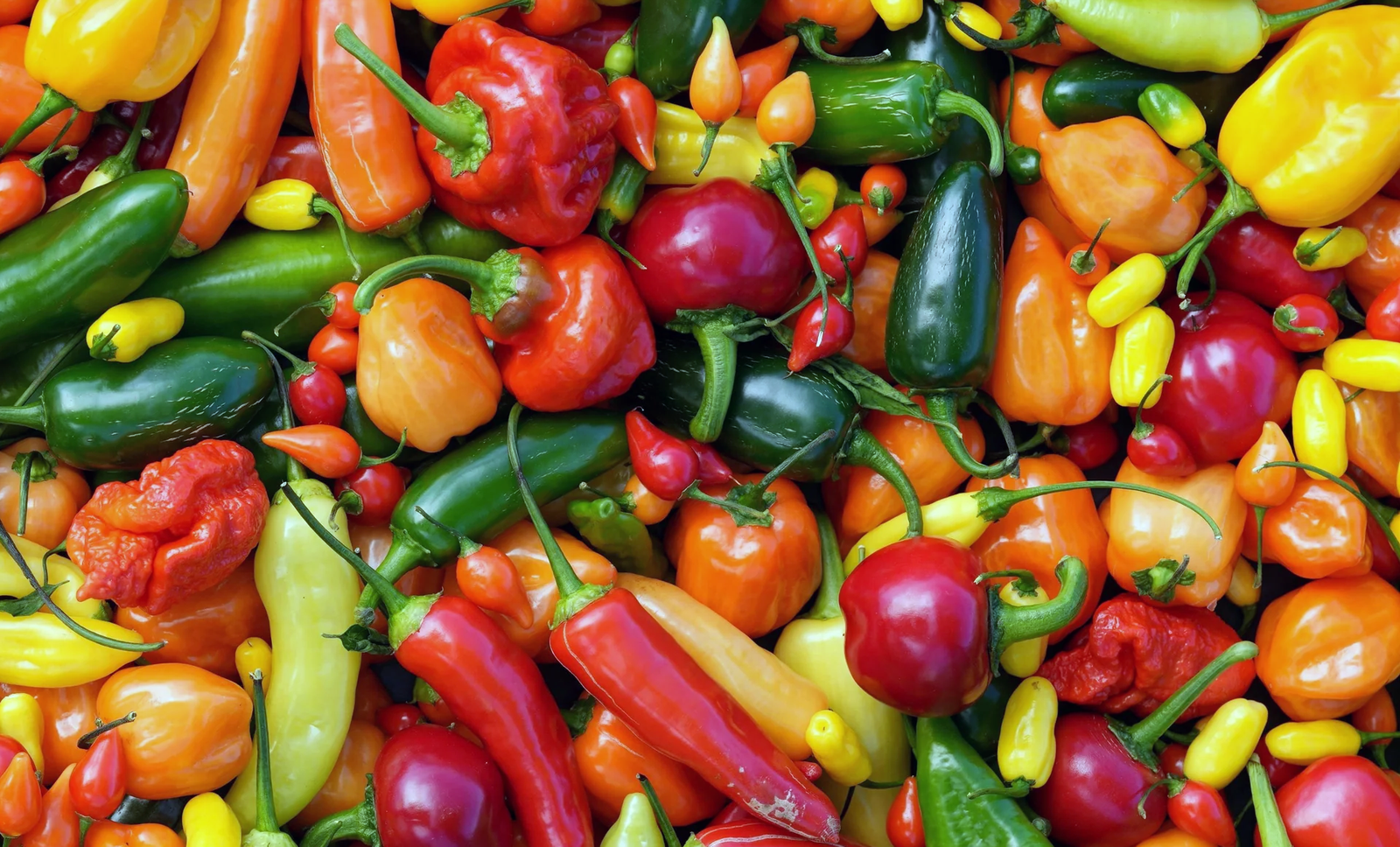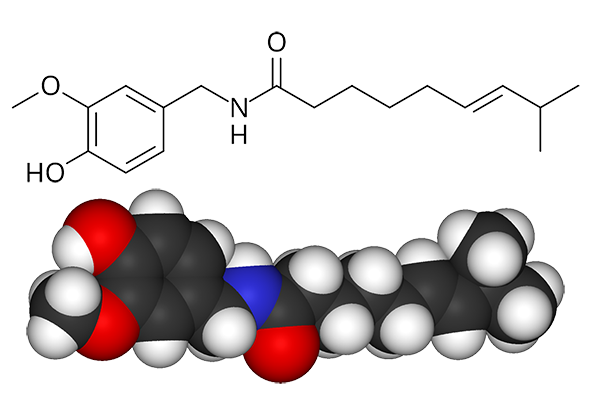FabulousFusionFood's Chilli-based Recipes 9th Page
 A mixture of different chilli peppers.
A mixture of different chilli peppers.
Welcome to FabulousFusionFood's Chilli-based Recipes Page — The recipes presented here all contain chilli peppers as a main ingredient. Chillies are the fruit of the chilli plant. Along with black pepper, they are unique spices in that they impart 'heat' to a dish without any associated bitterness. The dried and powdered fruit along with the fresh fruit and the dried fruit are all used as spices. As well as their capsaicin induced heat, chillies (depending on the variety or cultivar) can also imbue a dish with a fruity flavour. Smoked chillies are also used to impart a smokiness as well as heat to a dish.
Chilli peppers, also spelled chile or chili (from Classical Nahuatl chīlli [ˈt͡ʃiːlːi]) and known as hot peppers, are varieties of berry-fruit plants from the genus Capsicum, which are members of the nightshade family Solanaceae, cultivated for their pungency. Chilli peppers are widely used in many cuisines as a spice to add "heat" to dishes. Capsaicin and the related capsaicinoids give chillies their intensity when ingested or applied topically. Chilli peppers exhibit a range of heat and flavours. This diversity is the reason behind the availability of different types of chilli powder, each offering its own taste and heat level.
Chilli peppers originated in Central or South America and were first cultivated in Mexico. European explorers brought chillies back to the Old World in the late 16th century as part of the Columbian Exchange, which led to the cultivation of multiple varieties across the world for food and traditional medicine. Five Capsicum species have been widely cultivated: annuum, baccatum, chinense, frutescens, and pubescens.
 The capsaicin molecule, chemical structure (top) and space-filling model (bottom).
The capsaicin molecule, chemical structure (top) and space-filling model (bottom).
When peppers are consumed by mammals such as humans, capsaicin binds with pain receptors in the mouth and throat, potentially evoking pain via spinal relays to the brainstem and thalamus where heat and discomfort are perceived. However, birds are unable to perceive the hotness and so they can eat some of the hottest peppers. The intensity of the "heat" of chillies is commonly reported in Scoville heat units (SHU), invented by American pharmacist Wilbur Scoville in 1912. Historically, it was a measure of the dilution of an amount of chilli extract added to sugar syrup before its heat becomes undetectable to a panel of tasters; the more it has to be diluted to be undetectable, the more powerful the variety, and therefore the higher the rating. Since the 1980s, spice heat has been assessed quantitatively by high-performance liquid chromatography (HPLC), which measures the concentration of heat-producing capsaicinoids, typically with capsaicin content as the main measure
The alphabetical list of all the chilli-based on this site follows, (limited to 100 recipes per page). There are 1392 recipes in total:
Page 9 of 14
| Missi Roti Origin: India | Mzoura (Tunisian Spiced Parsnips) Origin: Tunisia | Nigerian Fresh Fish Pepper Soup Origin: Nigeria |
| Mitmita Origin: Ethiopia | N'dolé (Bitterleaf Stew) Origin: Cameroon | Nigerian Goat Stew Origin: Nigeria |
| Mixed Mushroom Soup with Chu Hou Origin: Fusion | N'dolé avec Poisson (Fish and Bitterleaf Stew) Origin: Gabon | Nigerian Guinea Fowl Stew Origin: Nigeria |
| Miyan Kuka II (Baobab Leaf Soup II) Origin: Nigeria | N'dolé avec Poulet (Chicken N'Dolé) Origin: Cameroon | Nigerian Guineafowl Pepper Soup Origin: Nigeria |
| Moambé Stew Origin: Congo | Nadan Kozhi Curry Origin: India | Nigerian Seasoning Mix Origin: Nigeria |
| Mofo Sakay (Spiced Fritters) Origin: Madagascar | Nadru Yakhni Curry (Lotus Stem and Yoghurt Curry) Origin: India | Nigerian Spiced Grasscutter Pepper Soup Origin: Nigeria |
| Mole Verde (Green Mole) Origin: Mexico | Naga Bhuna Karahi Origin: Britain | Nigerian Spicy Scrambled Eggs Origin: Nigeria |
| Molho de Piri-Piri (Mozambican Peri-peri Sauce) Origin: Mozambique | Naga Chicken Curry Origin: Britain | Nigerian-style Spaghetti Origin: Nigeria |
| Momos Chutney Origin: India | Naga Curry Origin: Fusion | Nigeria’s Mother Sauce Origin: Nigeria |
| Montserratian Fisherman's Stew Origin: Montserrat | Naga Mircha Pickle (Naga Chilli Pickle) Origin: India | Nila Bumbu Acar (Sour Spicy Carp) Origin: Indonesia |
| Montserratian Green Seasoning Origin: Montserrat | Nali Sauce (Piri-piri Sauce) Origin: Malawi | Nilgiri Chicken Korma Origin: India |
| Moqueca de Peixe (Braised Whole Fish) Origin: Guinea-Bissau | Nam Pla Prik (Chillies in Fish Sauce) Origin: Thailand | Nkatenkwan (Ghanaian Peanut Soup) Origin: Ghana |
| Moqueca de Pixe à Baiana (Grilled Fish, Baian Style) Origin: Brazil | Nam Pla Prik (Thai Spicy Fish Sauce) Origin: Thailand | Num Pa-chok Tirk Ka-chuii (Khmer Noodle Soup with Fingerroot) Origin: Cambodia |
| Moroccan Shish Sesame Skewers Origin: Morocco | Nam Prig Pow (Roasted Chilli Paste) Origin: Thailand | Nuoc Mam Cham (Fish Dipping Sauce) Origin: Vietnam |
| Mother-in-law Masala Origin: South Africa | Nam Prig Pud (Fried Chill Paste) Origin: Thailand | Nyeleng (Beef and Peanut Gumbo) Origin: Senegal |
| Moula Kawal (Kawal Sauce) Origin: Chad | Nam Ya Curry Paste Origin: Thailand | Nyma ye Huku (Zimbabwean Chicken Stew) Origin: Zimbabwe |
| Moyo de Poulet Fume (Moyo of Smoked Chicken) Origin: Benin | Namibian Black-eyed Peas Origin: Namibia | Nyona Penang Assam Laska Origin: Malaysia |
| Mozambique Peri-Peri Origin: Mozambique | Nandji Origin: Mali | Obe Eja Dindin (Fried Fish Stew) Origin: Nigeria |
| Mozambique Prawns Origin: Mozambique | Nandji de Boeuf (Nandji of Beef) Origin: Cote dIvoire | Obe Eja Tutu (Fresh Fish Stew) Origin: Nigeria |
| Muamba de Cabara (Goat Meat Muamba) Origin: Angola | Native Jerk Seasoning Origin: Jamaica | Ock-lam (Barbecued Pork with Mushrooms and Beans) Origin: Laos |
| Muamba de Galinha (Angolan Chicken Muamba) Origin: Angola | Ndolé à la Viande (Bitterleaf with Meat) Origin: Cameroon | Ocopa de Camarones (Prawn Ocopa) Origin: Peru |
| Muamba Nsusu (Congo Chicken Soup) Origin: Congo | Ndomba de Poisson (Fish Cooked in Banana Leaves) Origin: Cameroon | Ofada-Ugba Jollof (Fermented Jollof Rice) Origin: Nigeria |
| Mufete de Causo (Grilled Tilapia with Onion and Chilli Sauce) Origin: Angola | Ndomba de Porc (Pork Cooked in Banana Leaves) Origin: Cameroon | Ofe Achara (Elephant Grass Stew) Origin: Nigeria |
| Mufete de Sardinha (Grilled Sardines with Onion and Chilli Sauce) Origin: Angola | Nepalese Meat Masala Origin: Nepal | Ojinguh Jut (Korean Pickled Squid) Origin: Korea |
| Mulet Farci à la Saint-Louisienne (Stuffed Mullet in the style of Saint-Louis) Origin: Senegal | Nepalese Mustard Greens Bhutuwa Origin: Nepal | Ojojo Origin: Nigeria |
| Mullet Soup Origin: Cornwall | Nepalese Mustard Greens Bhutuwa Origin: Nepal | Old Bay Seasoning Mix Origin: American |
| Mulligatawny Soup Origin: Anglo-Indian | Nettle Greens and Peanut Stew Origin: African Fusion | Oleleh Origin: Sierra Leone |
| Murga aur Kanguchi (Chicken and Mushrooms) Origin: India | Nevis Hot Pepper Sauce Recipe Origin: Saint Kitts | Oleleh (Gambian Moi Moi) Origin: Gambia |
| Mushroom Chilli Dry Fry Origin: Britain | New Mexico Powder Origin: American | Olio di Peperoncino (Chilli Oil) Origin: Italy |
| Mushroom Madras Origin: Britain | New Zealand Chicken Curry Origin: New Zealand | Opor Ayam (Java Chicken Curry) Origin: Indonesia |
| Mutton in the Burmese Style Origin: Fusion | Nigeria Challenge BIR Curry Origin: Fusion | Oriental-inspired Haw Sauce Origin: Fusion |
| Mutton Rendang Origin: Indonesia | Nigerian Catfish Stew Origin: Nigeria | Oyster Mushroom Tom Yum (Thai Hot and Sour Soup with Oyster Mushrooms) Origin: Thailand |
| Mutton Sukha Curry Origin: India | Nigerian Chicken Gravy Origin: Nigeria | |
| Mysore Bonda Origin: Italy | Nigerian Chicken Stew Origin: Nigeria |
Page 9 of 14